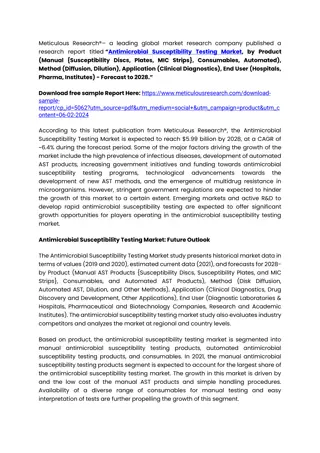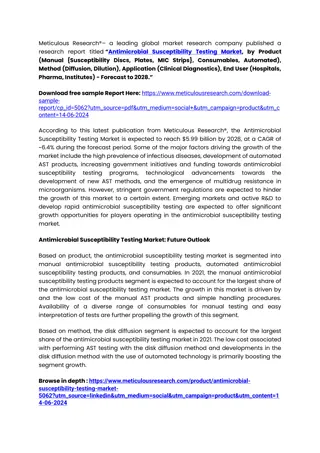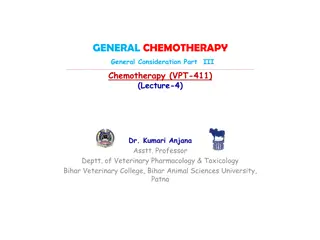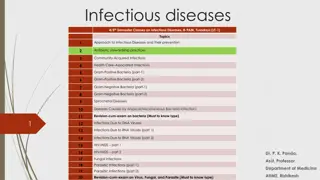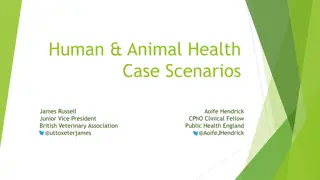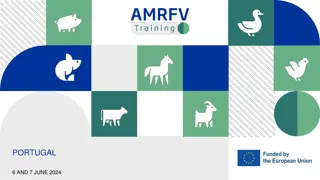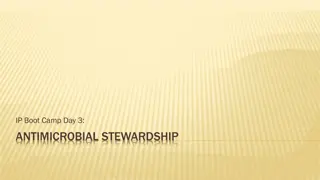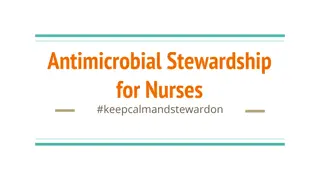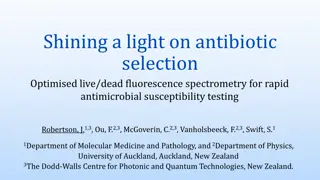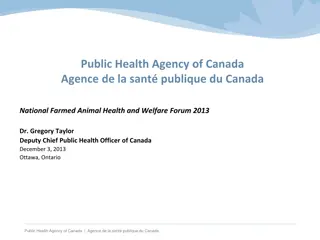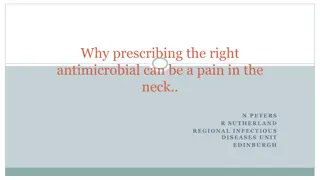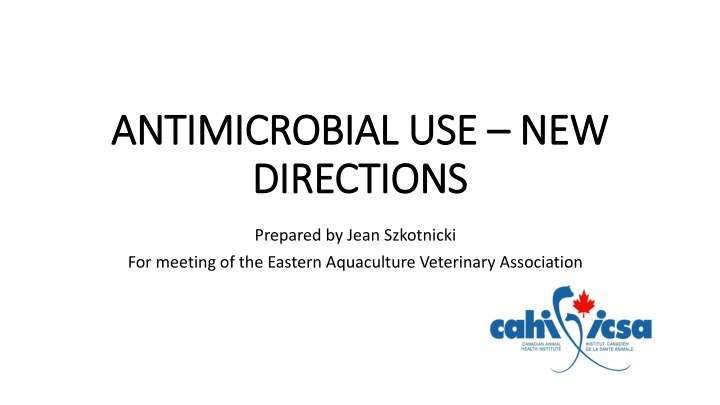
Regulatory Initiatives Impacting Veterinary Drug Importation and Use
Explore the regulatory and policy initiatives impacting the importation and use of veterinary drugs in Canada, including restrictions on personal use importation and the transition of certain drugs to prescription status. These initiatives aim to enhance oversight, improve quality control, and ensure the responsible use of antimicrobials in animal health.
Download Presentation

Please find below an Image/Link to download the presentation.
The content on the website is provided AS IS for your information and personal use only. It may not be sold, licensed, or shared on other websites without obtaining consent from the author. If you encounter any issues during the download, it is possible that the publisher has removed the file from their server.
You are allowed to download the files provided on this website for personal or commercial use, subject to the condition that they are used lawfully. All files are the property of their respective owners.
The content on the website is provided AS IS for your information and personal use only. It may not be sold, licensed, or shared on other websites without obtaining consent from the author.
E N D
Presentation Transcript
ANTIMICROBIAL USE ANTIMICROBIAL USE NEW DIRECTIONS DIRECTIONS NEW Prepared by Jean Szkotnicki For meeting of the Eastern Aquaculture Veterinary Association
REGULATORY & POLICY INITIATIVES Regulatory Canada Gazette II May 17th , 2017 Regulatory Outcome Controls over Own Use Importation & Use of Active Pharmaceutical Ingredients Mandatory reporting of sales volumes by importers annually: species estimates Expansion of the low risk program to include food animal products Policy Outcomes Updating of labels: prescription drug list in the MIB & added compatibility claims Policy Removal of growth promotions claims from Medically Important Antimicrobials (MIA) All MIA (all formulations) to have prescription status Impacts veterinary oversight & distribution of MIA
These regulatory and policy initiatives are interconnected and mutually supportive: 1) Increasing oversight on importation of veterinary drugs (Personal Use Importation) new regulatory amendment 2) Increasing oversight on importation and quality of veterinary active pharmaceutical ingredients (APIs) new regulatory amendment 3) Reporting veterinary antimicrobial sales volume from manufacturers, importers and compounders to support surveillance new regulatory amendment 4) Facilitating access to low risk veterinary health products (VHPs), as additional tools for the maintenance of animal health and welfare new regulatory amendment and existing policy tools 5) Removing growth promotion claims from medically-important antimicrobials (MIAs) policy under existing regulatory tools 6) Increasing veterinary oversight over all MIAs (Prescription status switch) policy under existing regulatory tools
OVERSIGHT OF OWN USE IMPORTATION (OUI) OVERSIGHT OF OWN USE IMPORTATION (OUI) Current Situation Veterinary drugs, including over the counter antimicrobials, can be imported to Canada for own/personal use purposes with limited restrictions Personal use importation refers to importation by an individual for use on animal(s) under their care or guardianship, and not for further sale Regulatory Amendment Coming into force Nov 13, 2017 Prohibits importation of unapproved drugs for personal use, with an exemption for specified drugs that do not represent an unacceptable risk to public health and food safety Exempted product list Incorporated by Reference and established based on Health Canada s eligibility criteria List B: List of Certain Veterinary Drugs Which May Be Imported But Not Sold Only drugs on List B allowed to be imported for use in food-producing animals under the personal use provision List B drugs cannot be sold or given to someone else once they are imported into Canada
LIST B CRITERIA - OUI List B eligibility criteria the proposed product: is not a prescription drug for veterinary use in Canada is in its final dosage form and within its commercial packaging is not a medicated premix is not a medically important antimicrobial is approved by a recognised foreign regulator has an established maximum residue limit (MRL) in Canada for the active ingredient and species has similar directions for use to a product approved in Canada with a DIN has no unresolved safety issues Support from the relevant producer s association Details for requirements and application are under development and will be shared in the coming months
OVERSIGHT OF IMPORTATION AND QUALITY OF OVERSIGHT OF IMPORTATION AND QUALITY OF ACTIVE PHARMACEUTICAL INGREDIENTS (API) INGREDIENTS (API) ACTIVE PHARMACEUTICAL Current Situation Limited requirements on the importation of antimicrobials as APIs for vet use Manufacturers, importers and compounders of APIs for vet use are not required to have a Drug Establishment Licence (DEL) or to follow Good Manufacturing Practices (GMPs) Regulatory Amendment Coming into force May 17, 2018 (additional 14-month transition period ending July 17, 2019 to submit a DEL application) Expands existing GMP regulatory requirements for APIs used in human drugs to veterinary APIs when fabricating, packaging/labelling, testing, importing, distributing, or wholesaling Persons who fabricate, package/label, import and test active pharmaceutical ingredients (APIs) for veterinary use will be required to hold a DEL Pharmacists, veterinarians or those compounding a drug under the supervision of a licensed veterinarian to hold a DEL when importing medically important antimicrobials (MIAs) that are on Incorporated by Reference list List A: List of Certain Antimicrobial Active Pharmaceutical Ingredients
List A coming into effect November 13th , 2017 - Will apply to sales volume reporting requirements as well
APPROACH TO INSPECTION & LICENSING ON APPROACH TO INSPECTION & LICENSING ON QUALITY & IMPORTATION OF API QUALITY & IMPORTATION OF API Quality of Vet APIs As published in Canada Gazette II, an estimated 175 establishments may be engaged in licensable activities related to the regulatory amendments Veterinarians/pharmacists who would continue to import or compound 100 API manufacturers are anticipated to provide an EL application and are assumed to already be compliant with GMPs An inspection strategy will be applied to best address necessary inspections with available resources All current DEL and GMP guidance that applies to human drug API can be considered to be applicable to veterinary drug API the regulations and processes are similar Many DEL and GMP guidance documents and publications will be revised this may take some time for all to be finalized Webinar(s) being considered before the coming into force
APPROACH TO INSPECTION & LICENSING ON QUALITY APPROACH TO INSPECTION & LICENSING ON QUALITY & IMPORTATION OF API & IMPORTATION OF API Regulatory Amendment Coming into force May 17, 2018 (additional 14- month transition period ending July 17, 2019 to submit a DEL application) Commercial import of a veterinary API will require a DEL submission by July 17, 2019, including foreign manufacturing sites. Submissions received prior to this date will remain valid until a determination is made on the application Compounders of List A ingredients will be subject to the DEL requirements as of July 17, 2019 13
SALES VOLUME REPORTING SALES VOLUME REPORTING Current Situation No regulatory authority to collect sales volume for drugs Sales information submitted voluntarily via CAHI to PHAC Regulatory Amendment Sales reports must be submitted every year by March 31, starting with sales from calendar year 2018 that must be submitted starting Jan 1, 2019 and by March 31, 2019 Requires annual reports on the sale of veterinary antimicrobials considered important in human medicine that are on Incorporated by Reference list List A: List of Certain Antimicrobial Active Pharmaceuticals Manufacturers, importers and compounders to submit sales reports of drugs (final dosage form and API) on List A, including a)total quantity sold or compounded b)approximate quantity sold or compounded for each intended animal species
REGULATORY PATHWAY FOR VETERINARY HEALTH PRODUCTS REGULATORY PATHWAY FOR VETERINARY HEALTH PRODUCTS Current Situation No regulatory provisions for import and sale of low risk veterinary health products (VHPs) Voluntary Interim Notification Pilot Program (INPP) administered by 3rd party Regulatory Amendment Coming into force Nov 13, 2017 Risk-based regulatory pathway to allow importation and sale of low risk VHPs for use in animals, including food animals. VHPs are drugs in dosage form used to maintain or promote the health and welfare of animals (e.g. products that contain vitamins and minerals, botanicals, traditional medicines and homeopathics), but are not used to treat or cure disease; Active, homeopathic and traditional medicine substances permitted in VHPs are on Incorporated by Reference list List C: Veterinary Health Products Requires companies to notify Health Canada 30 days before selling a VHP or making a change to a marketed VHP; Labels to state Veterinary Health Product ; Serious adverse drug reactions to be reported; following Good Manufacturing Practices for human natural health products
VETERINARY HEALTH PRODUCT REGULATORY PATHWAY Regulatory Amendment Coming into force Nov 13, 2017 Health Canada takes a risk based approach when a non-compliance to the FDA/FDR is identified Veterinary Health Products (List C ingredients) will be required to be in compliance with the FDA/FDR when imported A VHP for a food-producing animal that is not notified cannot be imported unless it is on List B 17
POLICY INITIATIVES POLICY INITIATIVES VETERINARY OVERSIGHT REMOVAL OF THE GROWTH PROMOTION CLAIMS
VETERINARY OVERSIGHT OF MIA POLICY CHANGES VETERINARY OVERSIGHT OF MIA POLICY CHANGES Policy Initiative To promote prudent use, Health Canada is proposing to move all remaining MIAs to prescription status (via the Prescription Drug List (PDL)), since supervision by a licensed veterinarian in treatment decisions is an important part of antimicrobial stewardship Since 2004, new MIAs approved by Health Canada have been included on the PDL and must be sold pursuant to a prescription; so with this proposal, there will be the same level of oversight for those remaining MIAs approved prior to 2004 All in-feed MIAs to be included in CFIA s CMIB, and require a Prescription (Pr) prior to sale for on-label products ~340+ products implicated in all dosage forms (with about 75 in-feed MIAs) Update Notice to Stakeholders posted February 13, 2017 http://www.hc-sc.gc.ca/dhp-mps/vet/antimicrob/amr-notice-ram-avis-2017-eng.php
MIA IMPLICATED IN SWITCH FROM OTC TO PR MIA IMPLICATED IN SWITCH FROM OTC TO PR Apramycin Bacitracin Erythromycin Lincomycin Neomycin Penicillin G Spectinomycin Streptomycin/Dihydrostreptomycin Sulphonamides Tetracycline/Chlortetracycline/Oxy tetracycline Tilmicosin Tiamulin Tylosin/Tylvalosin Virginiamycin Or their salts or derivatives
Federal Rules Federal Rules WHO CAN SELL A DRUG WHO CAN SELL A DRUG The Food and Drug Regulations contain rules about the sale of prescription drugs C.01.043 A person may sell a prescription drug to a. a drug manufacturer; b. a practitioner; c. a wholesale druggist; d. a pharmacist; or e. the Government of Canada or the government of a province, for the use of a department or agency of that government, on receipt of a written order signed by the minister responsible for the department or by the person in charge of the agency, or by their duly authorized representative. C.01.041 No person shall sell a prescription drug unless they are entitled under the laws of a province to dispense a prescription drug and they sell it in that province under a verbal or written prescription that they received; orthey sell it under section C.01.043. Requirement to follow record keeping for at least 2 years
Path Forward for Path Forward for In In- -feed Medications feed Medications containing MIAs containing MIAs All approved in-feed drugs (including OTC and Pr) to be included in CFIA s Canadian Medicating Ingredients Brochure (CMIB) A veterinary prescription will be required prior to sale when an MIA drug is mixed in livestock feed There will be no restriction on manufacturing (floor stocking) of such MIA-medicated feeds if manufactured pursuant to Health Canada approvals (i.e. as per CMIB) Restrictions remain if manufacturing a medicated feed in a manner deviating from Health Canada s approvals and Veterinary prescriptions will continue to be required prior to manufacturing (i.e. no floor stocking) 7
Future Distribution Pathway for Future Distribution Pathway for In In- -feed Medications feed Medications containing MIAs containing MIAs All in-feed MIAs (with Pr status) when sold as a drug pre-mix (before being mixed in feed/i.e. bag with a DIN) can be dispensed only by persons entitled under provincial rules to dispense a Prescription drug (e.g. veterinarian, pharmacist), and with a valid prescription [C.01.041 applies] Commercial Feed mills can continue to dispense mixed feed containing MIAs pursuant to a Pr [under C.01.043 and Feeds Regulations]; typically, medications containing MIAs (with a DIN) can be mixed into feed and dispensed by Commercial Feed mills as: Medicated Complete feed Medicated Supplement Medicated Macro Pre-mix Medicated Micro Pre-mix Prescription required before sale and record keeping rules apply (Federal oversight) On-Farm Feed Mills Access to medications would be limited to any of the above 4 forms from a commercial feed mill pursuant to a Pr (Federal Rules) or Via accessing the drug-premix (DIN) product pursuant to a Prescription from individuals entitled under the Provincial rules (e.g. veterinarians, pharmacists)
Revised CMIB structure: Revised CMIB structure: All in-feed veterinary drugs to be included in CMIB (regardless Pr or OTC) Four indexes to facilitate easy location of medicating ingredients; o active ingredient o brand name o species and class o company name Three sections for each MIB o introductory profile of the medicating ingredient o specifications to follow for each claim for which the medicating ingredient is permitted to be used o listing of accepted compatibilities for that particular medicating ingredient Proposing to eliminate the MIB #s 10
Health Canada Proposed Target Timelines & Actions Health Canada Proposed Target Timelines & Actions Scope: ~340+ product labels (~64 of these products will also have GP claims removed, and ~75 of these products are in-feed and will be added by CFIA to the CMIB) June 2017 PDL Notice of Consultation (75 days). Companies to be advised of their impacted label changes (Pr and growth promotion claims) Companies to start submitting updated labels for VDD review and approval CFIA to start updating CMIB in parallel with VDD review work September 2017 PDL Notice of Intent to Amend Noting intended final PDL listing of February 2018 Noting intended final effective date of December 2018 (proposal for further discussion) February 1, 2018 Notice of Final PDL, noting intended final effective date NOCs/Final Approved Labels issued to companies CMIB updated with all in-feed MIAs (to be rolled out April 2018)
TRANSITIONING THROUGH TO 2018 Additional Considerations Access of Pr drugs for Minor Species including honey bees Availability of species specific veterinarians in remote areas Impact on access to Prescription products in remote areas Education and Awareness for in-feed MIA changes E-template for Prescription Opportunity for consistent rules for dispensing and distribution of Pr drugs across provinces 15
RESPONSIBLE USE LOGO FOR MIA USED RESPONSIBLE USE LOGO FOR MIA USED IN VETERINARY MEDICINE IN VETERINARY MEDICINE
CAHPRAC Subcommittee on Antimicrobial Resistance Engagement Initiative Course of Action Approach to Joint Engagement 1. Agreement on the concept of a communication campaign that provides topics and key messages to stakeholders. 2. Campaign feel to include the responsible use logo. 3. Identification of roles and responsibilities. 4. Factsheet topics and key messages to be agreed upon. 5. Use of stakeholder logos in communications products e.g. factsheets, posters, media articles. 6. Stakeholder parties to have the flexibility to customize communications to ensure relevancy to their constituents. 7. Outreach to other media sources e.g. Canadian Cattlemen, Better Farming, provincial and national producer associations, provincial veterinary associations and colleges.
CAHPRAC Engagement Strategy Confidential Draft Information
CAHPRAC Engagement Strategy
CAHPRAC Engagement Strategy


